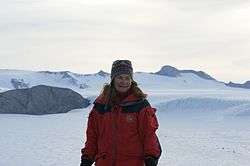Elisabeth Isaksson
| Elisabeth Isaksson | |
|---|---|
 | |
| Nationality | Sweden |
| Fields |
Glaciology Geology |
| Institutions | Norwegian Polar Institute |
| Alma mater |
BSc Umeå University MSc University of Maine PhD Stockholm University |
|
Website Elisabeth Isaksson at the NPI | |
Elisabeth Isaksson is a Swedish glaciologist and geologist who has researched polar climate history on the basis of ice cores. She has also studied snow and ice pollution on the Norwegian island of Svalbard and has participated in award-winning European projects on Antarctic climate change.[1][2]
Education
Isaksson graduated in geoscience at Umeå University in 1986. She went on to gain an Fil. Lic. from Stockholm University and an M.Sc. from the University of Maine in 1991. With a thesis on Climate records from shallow firn cores, Dronning Maud Land, Antarctica,[3] she was awarded a Ph.D. from Stockholm University in 1994.[1]
Career
Isaksson was a research assistant on Antarctic projects at Stockholm University (1988–1995), before becoming a glaciologist at the Norwegian Polar Institute in February 1995, a position she maintains today as head of the Geology and Geophysics department.[1][4] Since 2001, she has worked on ice-core records from Lomonsovfonna on Svalbard, contributing to a number of papers on climate change over the past 800 years.[5]
Thanks to changes in attitudes towards the acceptance of women in the field since the 1990s, Isaksson has been able to work as a glaciologist for over 25 years. While working on her doctorate under Wibjörn Karlén, she undertook research on Kebnekaise, Sweden's highest mountain.[2] At the Norwegian Polar Institute, she has contributed to research on holocene climate changes in the Antarctic from ice and marine-sediment core, nuclear fallout over Norwegian territories, and collaborative work with the United States on climate variability in East Antarctica.[1] Isaksson has been a key participant in the European EPICA Antarctic climate project which received the Descartes Prize in 2007.[6]
Personal life
In 1990, Isaksson married the American glaciologist Jack Kohler from Philadelphia who is also employed by the Norwegian Polar Institute. They have two children. Their home is in Tromsø in the far north of Norway.[7]
References
- 1 2 3 4 "Elisabeth Isaksson". Norwegian Polar Institute. Retrieved 3 August 2016.
- 1 2 Aukland, Kristin (14 May 2014). "Do you have to be a tough man to be a polar researcher?". kifinfo.
- ↑ Altnau, S; Schlosser, E; Issaksson, E; Divine, D (7 May 2015). "Climatic signals from 76 shallow firn cores in Dronning Maud Land, East Antarctica" (PDF). The Cryosphere, 9, 924-944, 2015. Retrieved 3 August 2016.
- ↑ Vinje Jenssen, Elin (1 April 2014). "Kvinnene inntar polarområdene via jobben" (in Norwegian). Norsk Polarinstitutt. Retrieved 3 August 2016.
- ↑ "Two ice-core δ18O records from Svalbard illustrating climate and sea-ice variability over the last 400 years" (PDF). The Holocene, 15,4. 2005. pp. 501–509. Retrieved 3 August 2016.
- ↑ "Norwegian winner of Descartes Prize". The Research Council of Norway. 27 March 2008. Retrieved 3 August 2016.
- ↑ Hurdle, Jon (2003). "Hooked on Glaciers". The Pennsylvania Gazette. Retrieved 3 August 2016.